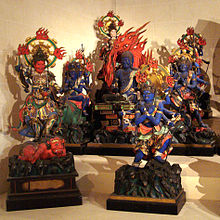- Wisdom King
-
In Vajrayana Buddhism, a Wisdom King (Sanskrit विद्याराज vidyarāja, Chinese Míngwáng 明王, Japanese 明王 myō-ō) is the third type of deity after Buddhas and bodhisattvas. The Sanskrit name literally "king of knowledge", thus the Chinese character "明", meaning knowledgeable (and/or bright) is used, leading to wide array of alternative English names including Radiant King, among others like Guardian King, etc. Wisdom Kings belong to the Buddhist Pantheon. In Tibetan Buddhism, they are known as Heruka.
The female counterparts of Wisdom Kings are known as Wisdom Queens (Ch: Míngfēi 明妃; Jp: 明妃 myōhi), although the distinction is often ignored.
Contents
Doctrine
On a general level, the Wisdom Kings are viewed as the guardians of Buddhism, and fierce manifestations of Buddhas. In particular, the Five Wisdom Kings are the protectors of the Five Wisdom Buddhas.[1]
According to the esoteric doctrine of the Three Wheels, whereas Buddhas represent pure concepts and bodhisattvas teach through compassion, Wisdom Kings are the embodiment of the wheel of injunction and teach through fear, shocking nonbelievers into faith.[1]
Iconography
Part of a series on
Buddhism
Dharma or concepts
Four Noble Truths
Five Aggregates
Impermanence
Suffering · Non-self
Dependent Origination
Middle Way · Emptiness
Karma · Rebirth
Samsara · CosmologyPractices
Three Jewels
Noble Eightfold Path
Morality · Perfections
Meditation · Mindfulness
Wisdom · Compassion
Aids to Enlightenment
Monasticism · LaityNirvāṇa
Four Stages · Arahant
Buddha · BodhisattvaTraditions · Canons
Theravāda · Pali
Mahāyāna · Chinese
Vajrayāna · TibetanAs mentioned above, Wisdom Kings are usually represented as wrathful deities, often with blue skin, many arms, sometimes with many faces, and even many legs. They hold weapons in their hands and are sometimes adorned with skulls, snakes or animal skins and wreathed in flames.
A notable exception is Mahamayuri (Ch: Kǒngquè míngfēi 孔雀明妃 or Kǒngquè fómǔ 孔雀佛母; Jp: Kujaku myo-ō 孔雀明王), the "Peacock Wisdom Queen", who is usually presented with a peaceful expression. She is easily identifiable as she usually rides a peacock.
List of Wisdom Kings
The Five Wisdom Kings
 Five Wisdom Kings. Front left is a protective deity: the Heavenly King Zōchō, and back left another one: Heavenly King Kōmoku.
Five Wisdom Kings. Front left is a protective deity: the Heavenly King Zōchō, and back left another one: Heavenly King Kōmoku.
In the Shingon tradition of Vajrayana Buddhism, the Five Great Wisdom Kings (五大明王; Godai Myo-o,[2] Wǔ Dà Míngwáng), also known as the Five Guardian Kings are a group of Wisdom Kings who represent the luminescent wisdom of the Buddha and protect the Five Wisdom Buddhas. The Five Kings are usually defined as:
The Five Wisdom Kings inhabit the Womb Realm. They are organized according to the directions of the compass:
Vajrayaksa (north)
Yamantaka (west)
Acala (principal deity/ meditator)
Trilokavijaya (east)
Kundali (south)
Others
- Ragaraja (Aizen)
- Mahamayuri (Kujaku)
- Hayagriva (the horse-headed wrathful manifestation of Avalokitesvara)
- Ucchusma (Ususama)
References
- ^ a b Baroni, Helen Josephine (2002). The illustrated encyclopedia of Zen Buddhism. New York: Rosen Pub. Group. pp. 100. ISBN 0-8239-2240-5.
- ^ Brown, Steven T. (2001), Theatricalities of power: the cultural politics of Noh, Stanford University Press, p. 85, ISBN 0804740704, http://books.google.com/books?id=60YGrJVUrPMC&pg=PA85
- Mark and Luebeck,Walter Hosak (2006). Big Book of Reiki Symbols, The. Tokyo: Lotus Press. ISBN 0-914955-64-0.
- D. D. Jc Husfelt (2006). The Return of the Feathered Serpent Shining Light of 'First Knowledge': Survival and Renewal at the End of an Age, 2006-2012. Authorhouse. ISBN 1-4259-0546-3.
See also
- Dharmapāla and Lokapāla, the Protectors in Tibetan Buddhism
Categories:- Buddhist deities, bodhisattvas, and demons
- Dharmapalas
- Protector gods
Wikimedia Foundation. 2010.






